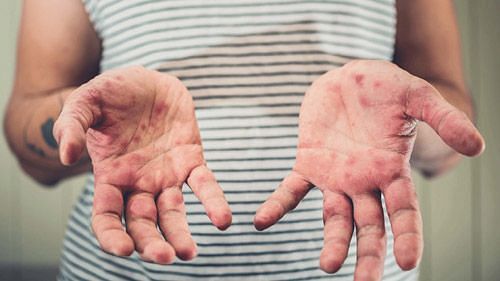What is Asteatotic Eczema?
Asteatotic eczema is a type of eczema that makes the skin patchy and dry. Read more to know about the symptoms, causes, treatment, and diagnosis of Asteatotic eczema.

Do you suffer from cracked skin? Are you looking for ways to treat skin conditions like eczema? Then, you have come to the right place.
There are more than 3000 skin diseases in existence, becoming one of the major concerns for people in recent years. Many skin-related issues are chronic, long-lasting and can affect a person’s life on a significant level.
Fortunately, all skin conditions are not serious concerns, but society makes people with skin conditions feel bad about their appearance. With the prevalence of so many skin diseases, it is difficult to diagnose the exact issue. Eczema is one such common skin condition.
Affecting 31 million people in the US each year, eczema occurs in various forms. One such common type of eczema is Asteatotic eczema.
This article has everything you need to know about Asteatotic Eczema, its symptoms, diagnosis, and prevention.
What Is Asteatotic Eczema?
Asteatotic Eczema or Xerotic Eczema is most common in older people. The name Asteatotic comes from the French word ‘eczema craquelé’ which means ‘cracked.’
Just like psoriasis, Asteatotic eczema shows red, patchy, and dry flakes on the skin. The situation may worsen when the patient scratches their skin as this may turn into more severe and chronic fissures.
However, Asteatotic eczema is more likely to be found among men above the age of 60 years.
Asteatotic eczema may also turn into scratch marks, swollen skin glands, and sometimes form blisters on the skin cells. It starts appearing on the shin first and spreads further to the chest, upper limbs, and trunk parts.
What causes Asteatotic Eczema?
The general cause of Asteatotic Eczema is the lack of essential oils and dehydration of the skin. This occurs due to the water loss from the outer layer of the skin.
Moreover, there might be some reasons for Asteatotic eczema among older people. It is mostly found among people living in less humid areas, usually occurring during the winter season.
Excessive use of soaps, bleaches, and detergents will strip out the layers of your skin, leaving it dry and flaky. In some cases, the use of towels and wearing coarse materials may damage your skin epidermis.
Thus, it is recommended to use moisturiser and essential oils for your hair and skin during winters, and in low humid areas. In extreme cases, the skin barrier may further deteriorate and cause conditions like atopic dermatitis.
Besides this, some other causes of Asteatotic eczema are:
- Weak immune system is a cause of asteatotic eczema
- Cellular stress is a cause of asteatotic eczema
- Irritants are a cause of asteatotic eczema
- Blood pressure medications are a cause of asteatotic eczema
- Improper diet is a cause of asteatotic eczema
- Use of some drugs such as Retinoids, Diuretics, and Protein Kinase might also cause asteatotic eczema.
- Derma rolling your hair without cleaning your derma roller is a cause of asteatotic eczema
Who gets Asteatotic Eczema?
Asteatotic eczema is common in older people. People with dry skin are more prone to this skin condition.
More prolonged exposure to sun or heat may also cause eczema. It is also found in people with:
- A history of Ichthyosis in genetic or inherited form.
- Some less common causes are those suffering from thyroid and malnutrition.
- Persons with weak immune systems, weight loss, and lymphoma may also suffer from eczema.
How is Asteatotic Eczema diagnosed?
Various forms of Asteatotic eczema can be diagnosed at its onset and can be identified by mere appearance. Though there are no specialised tests, some indirect tests can be used to diagnose this type of eczema.
Some dermatologists suggest that thyroid tests are viable to detect the onset of asteatotic eczema. These tests include hypothyroidism which is accompanied by dry and thinning hair, weight loss, and tiredness.
Early-onset of all types of eczema can also be diagnosed with regular scaling, weight loss, and fever in some cases. Such conditions might require specific tests for detecting the type of eczema.
What is the Treatment for Asteatotic Eczema?
Luckily, Asteatotic eczema is curable and can be treated within months or days if treated well. There are various remedies for Asteatotic eczema, including herbal medication and home remedies.
Home remedies can be used for treating less severe eczema conditions. To keep your skin hydrated and oily, you should have a proper diet, use coconut oil, and apply aloe vera gel on your skin’s surface.
Proper food habits will help you get clearer skin by detoxifying the body.
Some herbal medicines such as neem ointment, Vitamin-C, and aloe vera gel can help reduce eczema. Besides this, using a cleanser instead of soap can help in skin moisturisation.
Applying moisturisers like betnovate cream and emollients such as petroleum jelly to the reddened part of the skin for a few days can improve eczema.
You can also use Kumkumadi Tailam or Sapat Dr. Skin Lotion as a natural treatment to eczema.
Some dermatologists also suggest steroid creams in case of extreme eczema. However, we would always recommend not to use such steroid creams unless prescribed.

